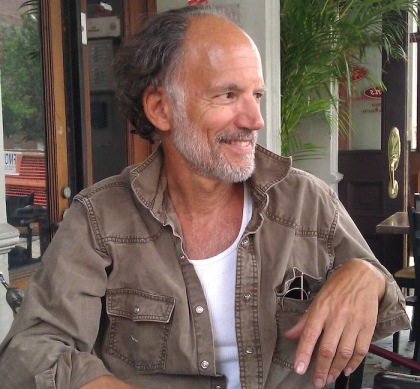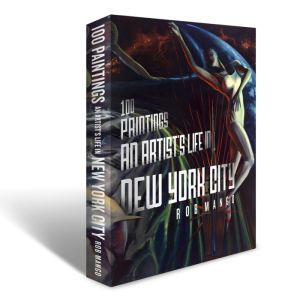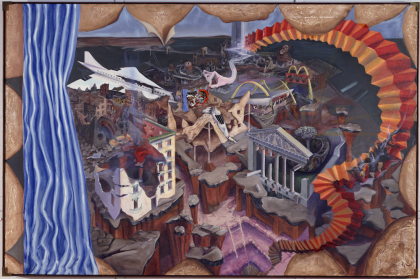Artist Rob Mango on Tribeca’s Pioneer Days

 When I learned that artist Rob Mango—whose gallery on Duane Park is a Tribeca institution—had a new book, 100 Paintings: An Artist’s Life in New York City, I assumed it was focused on his art. But it’s so much more: a memoir about his own life, and a vivid account of the birth of Tribeca as a residential neighborhood. He agreed to let me run several excerpts, along with the corresponding paintings. The book is available at Rob’s gallery at 178 Duane as well as robmango.com, Amazon, and Barnes & Noble.
When I learned that artist Rob Mango—whose gallery on Duane Park is a Tribeca institution—had a new book, 100 Paintings: An Artist’s Life in New York City, I assumed it was focused on his art. But it’s so much more: a memoir about his own life, and a vivid account of the birth of Tribeca as a residential neighborhood. He agreed to let me run several excerpts, along with the corresponding paintings. The book is available at Rob’s gallery at 178 Duane as well as robmango.com, Amazon, and Barnes & Noble.
In 1977, when I was 25, I finally made my move. I relocated from Chicago to a downtown New York neighborhood we later named Tribeca, or “Triangle Below Canal.” I needed a cheap place to work, preferably in an industrial loft area. After staying with Debbie French, a former girlfriend, I found an abandoned storefront, originally the New York Egg Auction Company, which had been a Washington Market staple since the turn of the century. This former butter and egg warehouse on cobblestoned Duane Street would become my living quarters and studio. When I arrived in November, my abandoned storefront was not equipped with radiators or lights, much less a kitchen or bathroom. I made a deal with the landlord for a few months of free rent in exchange for renovating the space and making it livable.
After a while I had a refrigerator, a hot plate and an oversized cable spool I turned on end to make a kitchen table. There were three restaurants in the neighborhood, only one open after 6 p.m.—a souvlaki joint, basically a small window in the ground floor of the Bond Hotel, a flophouse at the corner of Chambers and W. Broadway. Savory lamb shaved into pita bread and steaming strong black coffee in a thick blue and white paper cup with Greek writing on the side were pushed out in exchange for $1.25. I kept the paper cups to mix paint in later. An alternative was a bowl of onion soup au gratin ($2) at the River Run Café on Harrison Street. And then there was the Odeon. In those days, it was a working-class cafeteria. You pulled a ticket from the dispenser, picked up your tray, made the circuit around the steam tables, pointed at your hash browns or scrambled eggs, and Spanish-speaking guys would hand it over: all for $2.50.
The Twin Towers were not yet five years old. They rose out of the empty and desolate landfill, twinkling empirically, like the pyramids of Egypt; I assumed they’d always be there. The streets were deserted. It’s hard to believe now, in 2014, but below Canal Street in the late ’70s, night was a desolate time, with almost no traffic. There was no nightlife to speak of and few high-rise apartment buildings. I was among the first generation of loft pioneers.
My first attempt to capture the most difficult subject in my imagination’s domain was Return to the City. I had just built and stretched a 60 by 84 inch canvas and stained it with pale umber primer, an earthen hue. I did so because there was dirt below the streets, tunnels and century-old layers of crumbling brick foundations. I envisioned the picture while sprinting amazingly fast on New York’s deeply grooved asphalt backbone, granite sidewalks and cobblestone streets. I wanted to create a picture illustrating the dominant visual features of lower Manhattan as body parts; what lay below the streets would represent the unconscious mind.
Like the psyche obscured and unseen within us, the unconscious smolders under the asphalt, its hidden power animating the surface, like the rumble of the subway under your feet or the scalding manhole covers, apparent on any day in New York. Manhattan had become my muse, and she was almost too much to handle. But for one who craved work, with years of racing wins behind me, that was the only game worth playing.
Below: Return to the City (1985). Oil on canvas. 60 x 80 in. Private collection, New York City. Click to enlarge.














I’ve lived here since 1980 and I have to say I preferred the “old” Tribeca…without all the baby strollers. Yes, I know that’s not very PC but so what.
this is wonderful! thanks for posting… I was working in the advertising industry in the 80s – for Saatchi & Saatchi – and our offices moved downtown from midtown in 1987… we would wander down to Tribeca after work for drinks and it was dark, quiet and mysterious, even then… when I moved down there to live soon after 9/11, it still held the mystery and a sense of history but no longer…at every turn, mom & pop shops are being pushed out for chains and condos… it just makes me sad… it was a very special place
Happy to see the story in a book by one who was there for one of those transitions that have been happening ever since the English took over after the Dutch. I moved to the neighborhood in 1978 a few blocks south of you and indeed you tell it as it was…
Always good to see your artistry whether at your place or in a book.
Larry, cool to meet-up with you here in Tri Citizen. Erik has done a really wonderful job with his blog-spot.
. I really cherish the past years and witnessing the evolution of our daughters lives ,but the present seems to be even better. We are fortunate to live in a wonderful neighborhood and the greatest city in the world.
warm regards -Rob
I’m here since 77 as well and love that Mango still loves paints shows and thrives. Yes very different in the new Tri Burbia but my mirror tells me I too have morphed and evolved in ways beyond control.
Wicki-
It was amazing back in ’77.the people,& mood…,it was minimal…perfect.pls stop by.
luv to show you my book.
Rob
Swung by the Mango Machine while doing a painting of my own in Duane Park… what a fantastic location. The hood has come a long way from the “demilitarized war zone” as per Egon on Ghostbusters. Incidentally for those who didn’t know. Mango was a world class middle distance runner.
Rob, Good luck with the book. I have always admired you and your art.
Yo Rob!
Been checking out your progress, with my visits to Midlothian. Pleased to see that you are finally making progress. Looking forward to finding a copy of the book, I have a table with one short leg….this could be the solution!!!
Very Best to you & yours
Same old…Bob A
Hi Robert, just looking through the 22 photo slide, great work, I
Love 4 in particular, the dome with illusion coming in, the jester
Character with the whirl of colors, the black and white dancing images, and the goats with the lighting in the background, it’s me the cashier, tribeca hardware